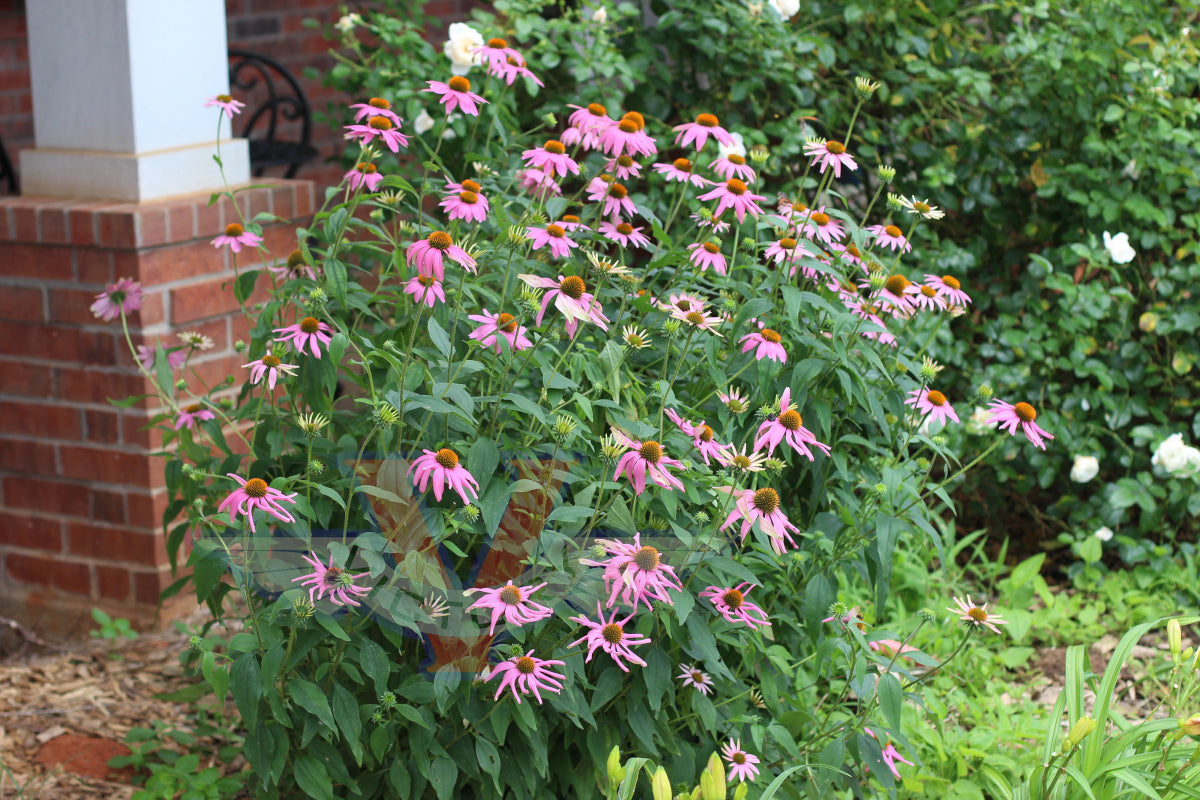Echinacea - Purple Coneflower
Echinacea - Purple Coneflower
Couldn't load pickup availability
Echinacea purpurea
Echinacea purpurea (also known as 'Eastern Purple Coneflower' or simply 'Purple Coneflower') is native to Eastern North American and in the sunflower family. It can now be found in the wild in much of the eastern, southeastern and Midwestern United States as well as in the Canadian Province of Ontario.
Although Echinacea became well known and quite popular for its medicinal properties during the later part of the twentieth-century, it is also a wonderful addition to your perennial flower garden.
It does well over a broad range of climate zones but does not grow in shady locations. It seems to do equally well in moist or dry soil, and once established, can tolerate drought conditions. Depending on the location, it blooms throughout the summer and into the early fall.
When starting from seed, daily temperature fluctuations or stratification is required to end dormancy. For best results, start seeds indoors in flats and transplant prior to the beginning of the growing season. Surface sow or cover no more than one-eighth inch deep.
Along with starting from seeds, once your plants are established, you can increase your population of them by division or cuttings. In the early spring or late fall, you can break up clumps and replant them. Additionally, in the late fall to early winter, you can also take cuttings of roots that are at least the diameter of a pencil, plant those, and they will develop into plants.
'Purple Coneflower' prefers locations that receive full sun and soil that is well-drained. A perennial in USDA zones 3-9. Each packet contains two grams of seeds, which is about 500 seeds.
![]() Echinacea has been used for centuries by the indigenous native Americans. The plant was used externally for wounds, burns, and insect bites, chewing of roots for toothache and throat infections; internal application is used for pain, cough, stomach cramps and snake bites.[6]
Echinacea has been used for centuries by the indigenous native Americans. The plant was used externally for wounds, burns, and insect bites, chewing of roots for toothache and throat infections; internal application is used for pain, cough, stomach cramps and snake bites.[6]
The mature roots of the plants are what contain the pharmacologically active substances and what are used for medicinal preparations. Fresh roots can be dried, powdered and encapsulated (one to two "00" capsules), made into a tincture (one teaspoonful), or made into a decoction (one tablespoonful). The dosage is of any of these three preparations, three to six times daily, depending on the severity of the infection or illness.[2,3,7]
Echinacea seems to be quite safe and does not usually cause side effects. One of the most extensive and systematic studies to review the safety of Echinacea products concluded that overall, "adverse events are rare, mild and reversible," with the most common symptoms being "gastrointestinal and skin-related."[4]
Additionally, there have been no case reports of any drug interactions with Echinacea and "the currently available evidence suggests that echinacea is unlikely to pose serious health threats for patients combining it with conventional drugs."[5] These reports confirm the earlier works of Tierra and Santillo.[2,3]




Germination Time 10 to 20 days
Plant Height 24 to 30 inches
Planting Depth 2X seed diameter
Spacing after Thinning 12 inches
Sow the seed in early spring through summer, up until two months before first fall frost. Choose an area that receives full sun and has rich soil. If the seeds are cold conditioned moist for about 2 weeks, germination will improve.
The flowers can be enjoyed cut, dried with the petals removed, and has also gained popularity for its medicinal properties.
| The Victory Seed Company does not advocate medical self-diagnosis or self-medication. Reference to the medicinal properties of plants are described here for educational and historical purposes only and are not to be construed as a prescription, prognosis or diagnosis for any disease or illness. As with any remedies or medicines, you should consult your personal health care provider before using. |
- "A Modern Herbal," Mrs. M. Grieve, 1931, p. 265.
- "The Way of Herbs: Revised and Expanded," Michael Tierra, C.A., N.D., Washington Square Press, New York, 1980, pgs. 123-124.
- "Natural Healing With Herbs," Humbart Santillo, B.S., M.H., Hohm Press, 1984, pgs. 112-113.
- "The safety of herbal medicinal products derived from Echinacea species: a systematic review," Alyson L. Huntley, Joanna Thompson Coon, and Edzard Ernst, Drug Safety Journal, May 2005, Volume 28, Issue 5, pgs. 387-400.
- "Interactions between herbal medicines and prescribed drugs: an updated systematic review," Angelo A. Izzo and Edzard Ernst, Drugs Journal, September 2009, Volume 69, Issue 13, pgs. 1777-1798.
- "Native American Ethnobotany," Daniel E. Moerman, Timber Press, 1998, p. 205.
- "The Herb Book," John B. Lust, N.D., D.B.M., Bantam Books, Inc., 1974, p. 129.
Explore our vegetable collections:
[ Artichokes | Asparagus | Beans | Beets | Broccoli | Sorghums | Brussels Sprouts | Cabbage | Cantaloupe | Carrots | Cauliflower | Celery | Collard Greens | Corn | Cucumber | Eggplant | Endives | Gourds | Kale | Kohlrabi | Leeks | Lettuce | Mesclun Mix | Mustard Greens | Okra | Onions | Parsley | Edible Pod Peas | Garden Peas | South Peas | Hot Peppers | Mild Peppers | Pumpkins | Radishes | Rapini | Rhubarb | Salad Greens | Salsify | Summer Squash | Winter Squash | Swiss Chard | Tomatillo | Tomatoes | Dwarf Tomato Project | Turnips | Watermelons ]




